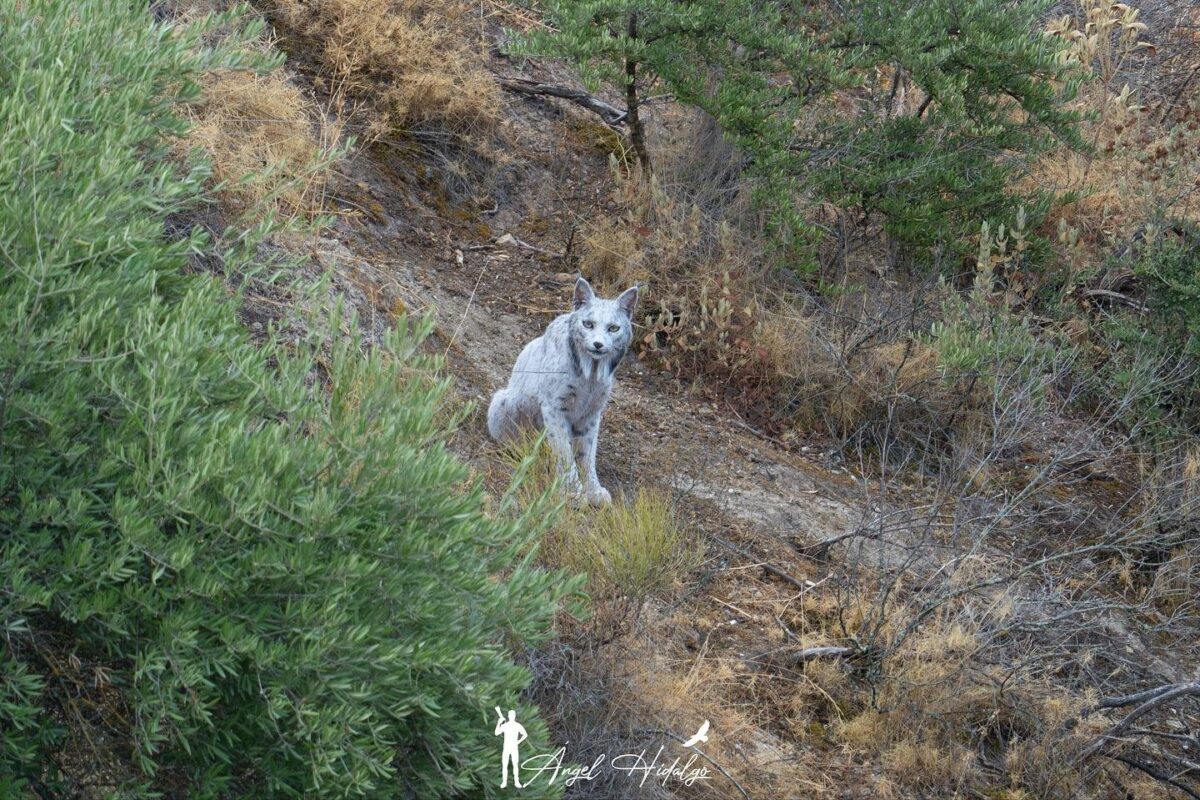In the scrublands of southern Spain, an amateur photographer has documented a biological first: a white Iberian lynx captured on camera in the wild. The images, now verified by conservation experts, show a rare leucistic individual — the only one of its kind ever recorded in this endangered species’ natural habitat.
The sighting occurred in the province of Jaén, within one of Andalusia’s established lynx populations. Photographer Ángel Hidalgo, 29, who works in construction, had set a camera trap more than a month ago in hopes of observing local wildlife. When he reviewed the footage, what appeared to be a ghostly white feline left him stunned. He spent weeks tracking the animal before finally observing and photographing it in person — a moment he later described as unforgettable.
The discovery arrives at a pivotal time for the Iberian lynx (Lynx pardinus), a species that has made one of the most dramatic comebacks in European conservation history. Once the world’s most endangered feline, its population now exceeds 2,400 individuals, according to Spain’s Ministry for the Ecological Transition (MITECO). This new sighting adds a rare genetic twist to that story — and raises new questions about the genetic health of the species.
Anomalous Coat Prompts Scientific Interest
Experts believe the animal is leucistic, not albino. Leucism causes a partial loss of pigmentation, often resulting in pale or completely white fur while retaining natural eye color. This differs from albinism, which results in a total absence of melanin and typically produces reddish or bluish eyes. According to National Geographic España, early evaluations have ruled out both albinism and typical leucism patterns, making this lynx even more genetically unusual.

The lynx was first captured on a motion-triggered camera before being sighted in person by Hidalgo at dawn after heavy rain. “I saw a white shape in the distance that seemed to emit its own light,” he said. His photographs clearly show a wild lynx with snow-white fur and natural, penetrating eyes — consistent with leucism but atypical in its full-body presentation.
Spanish researchers plan to investigate further through genetic testing and census tracking. The Life Lynxconnect project, backed by the European Union, coordinates conservation of lynx populations across Spain and Portugal and is expected to include this individual in its year-end population report.
Recovery of a Species Under Pressure
The Iberian lynx’s resurgence is one of the most closely watched wildlife recoveries in Europe. In 2002, the species’ global population had dipped below 100, making it the most endangered wild cat on Earth. Following years of targeted breeding, habitat restoration, and reintroduction programs, the lynx was reclassified from “endangered” to “vulnerable” by Spanish authorities in 2024.

MITECO reports a population increase of 18.8% in 2024 alone, with more than 470 breeding females now identified across 22 subpopulations in Spain and Portugal. The goal, according to the ministry, is to reach 3,500 individuals and 750 reproductive females to ensure long-term viability.
Despite these gains, major threats persist. Habitat fragmentation, road mortality, and declining rabbit populations — the lynx’s primary food source — continue to undermine conservation progress. The emergence of a leucistic individual may be a natural anomaly, but it could also signal potential genetic bottlenecks, particularly in small, isolated populations.
Sightings Fuel Interest in Public and Scientific Circles
The discovery has sparked interest beyond conservation circles. Hidalgo’s images have gone viral on Instagram, where he regularly shares wildlife photography from across Andalusia. While some viewers see the lynx as a symbol of nature’s resilience, others question whether it might also be a sign of reduced genetic diversity caused by inbreeding.
Experts urge caution in interpretation. “Leucism is rare but not necessarily problematic,” said a researcher affiliated with the Doñana Biological Station (CSIC), one of the institutions monitoring the lynx population. “Still, unusual traits in a recovering species warrant genetic study. We need to determine whether this is an isolated case or part of a broader trend.”
Hidalgo has deliberately withheld the precise location of the lynx to protect it from potential harm. Illegal hunting, although declining, remains a concern. In past years, lynxes have been killed by traps or poison meant for other animals, underscoring the ongoing need for protective legislation and public awareness.

